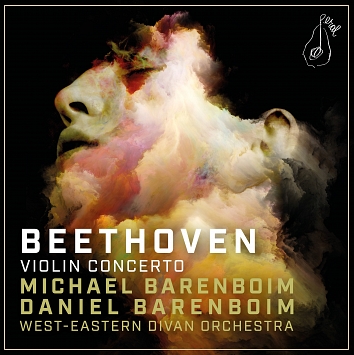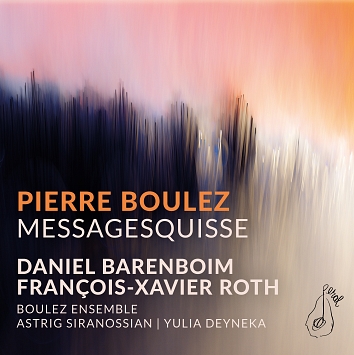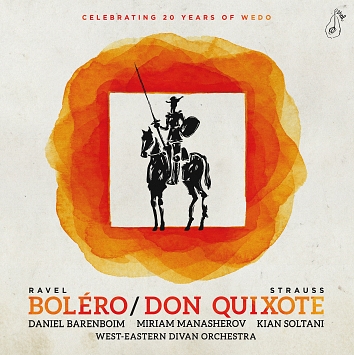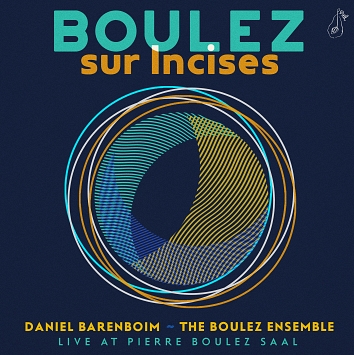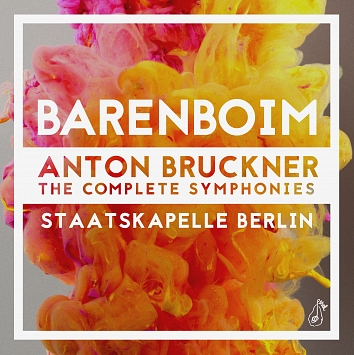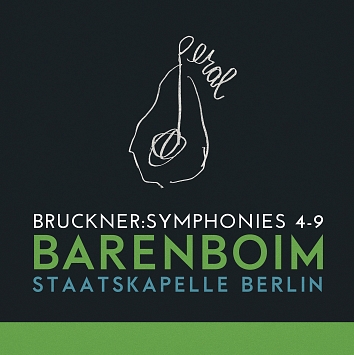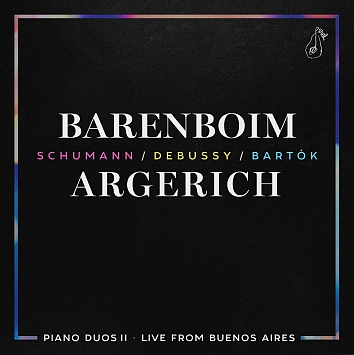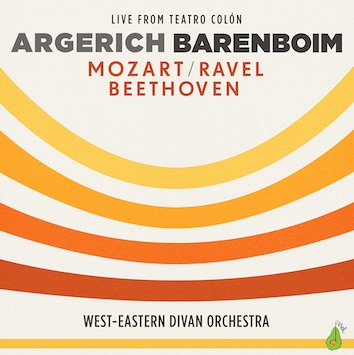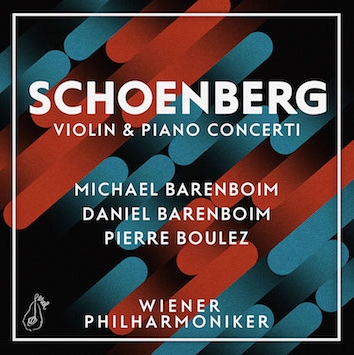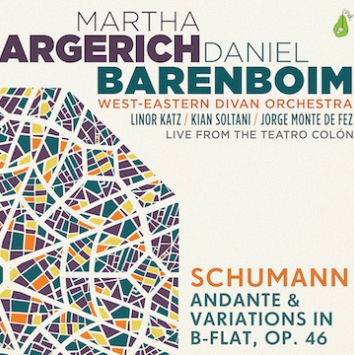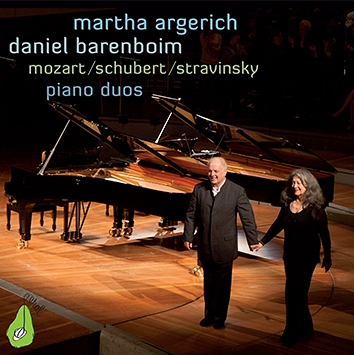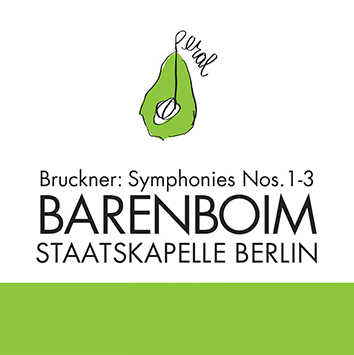Featured Recording
Beethoven: Piano Concerto No. 2
.jpg)
Now Available: Peral Music releases a new recording of Beethoven’s Piano Concerto No. 2, featuring the incomparable Martha Argerich and the West-Eastern Divan Orchestra. Peral Music founder Daniel Barenboim conducts.
Discover the albumthe philosophy of
Peral Music
A new record label for
listening to music in a digital world
Play Video
Peral invites curious minds to experience
music with focus and new insights.
Today, music is heard everywhere: at the office, in restaurants, in airplanes, and the like. Yet how often do we genuinely listen, and hear with thought and concentration?
Curated exclusively by pianist and conductor Daniel Barenboim and featuring unique listening guides, Peral is a new record label that invites curious minds to experience music with focus and new insights.
Embracing the possibilities of digital access, Peral Music offers audiences worldwide an alternative way of listening, resisting a culture of indifference by celebrating the thinking ear.
Recordings
Peral Music’s discography will feature Daniel Barenboim as conductor, with the Staatskapelle Berlin and the West-Eastern Divan Orchestra, and as pianist and chamber musician. In addition, Peral Music will offer educational resources for musicians-in-training, including a collection of studies performed and introduced by Barenboim. All releases will be offered as Mastered for iTunes, the highest-quality sound format available on the iTunes store globally.
Beethoven: Piano Concerto No. 2
Now Available: Peral Music releases a new recording of Beethoven’s Piano Concerto No. 2, featuring the incomparable Martha Argerich and the West-Eastern Divan Orchestra. Peral Music founder Daniel Barenboim conducts.
Beethoven: Violin Concerto
Violinist Michael Barenboim and Peral Music founder Daniel Barenboim join forces once again with the West-Eastern Divan Orchestra, this time to celebrate the music of Beethoven. The composer’s Violin Concerto, recorded during the orchestra’s 20th anniversary year and with Michael Barenboim as the soloist, is now available to stream and download on the Peral Label to mark the Orchestra’s glorious return to live music this summer.
Boulez: Messagesquisse
Peral Music presents two different takes on Boulez‘s groundbreaking Messagesquisse, a 1976 birthday greeting for Paul Sacher. This new 2-track eSingle presents one version for solo cello with Astrig Siranossian and conducted by Daniel Barenboim, followed by another arrangement for solo viola featuring Yulia Deyneka and conducted by François-Xavier Roth, who has been closely associated with the Boulez Ensemble ever since the opening of the Pierre Boulez Saal in Berlin.
Soloists: Astrig Siranossian (cello), Yulia Deyneka (viola)
Conductors: Daniel Barenboim, François-Xavier Roth
Celebrating 20 Years of WEDO
Daniel Barenboim and the West-Eastern Divan Orchestra celebrate the orchestra's twentieth anniversary with performances of Ravel's "Boléro" and Strauss's "Don Quixote." Featuring soloists Kian Soltani (cello) and Miriam Manasherov (viola).
Celebrating 20 Years of WEDO
Track List
Strauss: Don Quixote
- Introduction: Mäßiges Zeitmaß. Thema mäßig. "Don Quichotte verliert über der Lektüre der Ritterromane seinen Verstand und beschließt, selbst fahrender Ritter zu werden" ("Don Quixote loses his sanity after reading novels about knights, and decides to become a knight-errant")
- Theme: Mäßig. "Don Quichotte, der Ritter von der traurigen Gestalt" ("Don Quixote, knight of the sorrowful countenance")
- Maggiore: "Sancho Panza"
- Variation I: Gemächlich. "Abenteuer an den Windmühlen" ("Adventure at the Windmills")
- Variation II: Kriegerisch. "Der siegreiche Kampf gegen das Heer des großen Kaisers Alifanfaron" ("The victorious struggle against the army of the great emperor Alifanfaron") [actually a flock of sheep]
- Variation III: Mäßiges Zeitmaß. "Gespräch zwischen Ritter und Knappen" ("Dialogue between Knight and Squire")
- Variation IV: Etwas breiter. "Unglückliches Abenteuer mit einer Prozession von Büßern" ("Unhappy adventure with a procession of pilgrims")
- Variation V: Sehr langsam. "Die Waffenwache" ("The knight's vigil")
- Variation VI: Schnell. "Begegnung mit Dulzinea" ("The Meeting with Dulcinea")
- Variation VII: Ein wenig ruhiger als vorher. "Der Ritt durch die Luft" ("The Ride through the Air")
- Variation VIII: Gemächlich. "Die unglückliche Fahrt auf dem venezianischen Nachen" ("The unhappy voyage in the enchanted boat")
- Variation IX: Schnell und stürmisch. "Kampf gegen vermeintliche Zauberer" ("Battle with the magicians")
- Variation X: Viel breiter. "Zweikampf mit dem Ritter vom blanken Mond" ("Duel with the knight of the bright moon")
- Finale: Sehr ruhig. "Wieder zur Besinnung gekommen" ("Coming to his senses again" – Death of Don Quixote)
Ravel: Boléro
- Boléro
Boulez: Sur Incises
Daniel Barenboim joins the Boulez Ensemble for a live performance of Boulez's "Sur Incises" at the Pierre Boulez Saal.
Piano: Michael Wendeberg, Karim Said, Denis Kozhukhin
Harp: Aline Khouri, Stephen Fitzpatrick, Susanne Kabalan
Percussion: Dominic Oelze, Lev Loftus, Pedro Torrejón
Bruckner: The Complete Symphonies
"One of the characteristics of the Bruckner symphonies is that the music does not start as being 'here'. It rather becomes. In the later symphonies, you very often feel that this is a kind of delayed action. There’s no music, there are just strings trembling before the music actually starts..."
–Daniel Barenboim
Out now from Peral Music, Bruckner's Complete Symphonies performed by Daniel Barenboim and the Staatskapelle Berlin. Available now, exclusively on Apple Music.
Bruckner: The Complete Symphonies
Track List
Bruckner: The Complete Symphonies
- Bruckner: Symphony No. 1 in C Minor
- Bruckner: Symphony No. 2 in C MInor
- Bruckner: Symphony No. 3 in D Minor
- Bruckner: Symphony No. 4 in E-Flat Major
- Bruckner: Symphony No. 5 in B-Flat Major
- Bruckner: Symphony No. 6 in A Major
- Bruckner: Symphony No. 7 in E Major
- Bruckner: Symphony No. 8 in C Minor
- Bruckner: Symphony No. 9 in D Minor
Bruckner Symphonies 4-9
“You give the concentration, you listen, and if you hang on to the first note, you will travel to fantastic regions in a Bruckner Symphony.” –Daniel Barenboim
Discover Bruckner's symphonies with this release from Peral Music, available exclusively on Apple Music.
Bruckner Symphonies 4-9
Track List
Bruckner: Symphony Nos. 4-9
- Bruckner: Symphony No. 4 in E-Flat Major
- Bruckner: Symphony No. 5 in B-Flat Major
- Bruckner: Symphony No. 6 in A Major
- Bruckner: Symphony No. 7 in E Major
- Bruckner: Symphony No. 8 in C Minor
- Bruckner: Symphony No. 9 in D Minor
Piano Duos II
Legendary pianists Daniel Barenboim and Martha Argerich reunite for Piano Duos II, captured live in Buenos Aires. Listen to Debussy's "En blanc et noir," Schumann's Six Studies in Canon Form, and Bartók's Sonata for Two Pianos and Percussion – available worldwide on October 9, 2015, exclusively on iTunes.
Piano Duos II
Track List
- Schumann: Six Studies in Canon Form: I - Nicht zu schnell
- Schumann: Six Studies in Canon Form: II - Mit innigem Ausdruck
- Schumann: Six Studies in Canon Form: III - Andantino
- Schumann: Six Studies in Canon Form: IV - Innig
- Schumann: Six Studies in Canon Form: V - Nicht zu schnell
- Schumann: Six Studies in Canon Form: VI - Adagio
- Debussy: En blanc et noir: I - Avec emportement
- Debussy: En blanc et noir: II - Lent. Sombre
- Debussy: En blanc et noir: III - Scherzando
- Bartók: Sonata for 2 Pianos: I - Assai lento
- Bartók: Sonata for 2 Pianos: II - Lento, ma non troppo
- Bartók: Sonata for 2 Pianos: III - Allegro non troppo
Live from Teatro Colón
Live from Teatro Colón captures the long-awaited reunion of legendary pianists Daniel Barenboim and Martha Argerich in their home city of Buenos Aires, in concert with the West-Eastern Divan Orchestra.
“"[A] masterly return – a memorable concert – the audience at the Teatro Colón cheered as rarely before.””
La NaciónThe new album comprises Beethoven's First Piano Concerto with Argerich, Mozart's Overture to Le nozze di Figaro, and Ravel's Rapsodie espagnole, Alborada del gracioso, Pavane pour une infante défunte, and Bolero, as well as works by Schumann, Mores, and Bizet.
Live from Teatro Colón
Track List
- Mozart: Overture "Le nozze di Figaro", K.492
- Beethoven: 1. Allegro con brio [Piano Concerto No.1 in C Major, Op.15]
- Beethoven: 2. Largo
- Beethoven: 3. Rondo (Allegro scherzando)
- Schumann: 7. Traumes-Wirren [8 Fantasiestücke, Op.12]
- Ravel: 1. Prélude à la nuit [Rapsodie espagnole M.54]
- Ravel: 2. Malagueña [Rapsodie espagnole M.54]
- Ravel: 3. Habanera [Rapsodie espagnole M.54]
- Ravel: 4. Feria [Rapsodie espagnole M.54]
- Ravel: Alborada del gracioso, M.43
- Ravel: Pavane pour une infante défunte, M.19
- Ravel: Boléro, M.81
- Bizet: Aragonaise [Carmen Suite No.1]
- Bizet: Intermezzo [Carmen Suite No.1]
- Bizet: Les dragons d'Alcala [Carmen Suite No.1]
- Bizet: Les toréadors [Carmen Suite No.1]
- Mores: El Firulete
Schoenberg: Violin & Piano Concerti
Dating from 2005 and 2012, these are the Vienna Philharmonic’s first recordings of two of Schoenberg’s works: the Piano Concerto with Daniel Barenboim under Pierre Boulez and the Violin Concerto with Michael Barenboim under the direction of his father.
The Vienna Philharmonic has enjoyed a close bond with Schoenberg’s music, since he himself conducted two performances of his Gurre-Lieder in 1920 and afterwards wrote a personal letter of thanks, expressing his gratitude to the musicians for their work together. Since then there have been more than 100 performances of his works, and the orchestra even played an important part in the foundation of the Arnold Schoenberg Center in Vienna in 1998.
It is all the harder to believe that the Vienna Philharmonic had never previously played either of these two works.
For Daniel Barenboim the orchestra’s performances of Schoenberg’s music are full of “tenderness, good-natured informality and naturalness.” Their “playing is very much inspired by the venue.”
This makes it all the more inconceivable that these works by arguably the greatest composer of the 20th century, and a native of Vienna to boot, had been overlooked by the orchestra for so many years.
It was not until 2005 that Pierre Boulez conducted the Vienna Philharmonic’s first performance of Schoenberg’s Piano Concerto, when the soloist was Daniel Barenboim. Seven years later Barenboim returned with his son Michael and the two of them gave the first performance of Schoenberg’s Violin Concerto op. 36 with the orchestra. “Highly explosive music,” Michael Barenboim describes Schoenberg’s piece: “Every bar is aflame.” The work’s difficulties are plain. When it received its first performance in 1940, the composer’s daughter, Gertrud Greissle, remarked that “The difficulties are not purely intentional, but they are unavoidable.” Even today the virtuosity of Schoenberg’s Violin Concerto instils a sense of awe in many violinists. For a time Jascha Heifetz regarded the work as unplayable.
But for Barenboim, “Where other orchestras wrestle with the difficulties, the Viennese may do so as well, but they then discover themselves in the music, and this is really wonderful.”
Schoenberg: Violin & Piano Concerti
Track List
- Violin Concerto, Op. 36: I. Poco Allegro
- Violin Concerto, Op. 36: II. Andante grazioso
- Violin Concerto, Op. 36: III. Finale. Allegro
- Concerto for Piano and Orchestra, Op. 42: I. Andante
- Concerto for Piano and Orchestra, Op. 42: II. Molto Allegro
- Concerto for Piano and Orchestra, Op. 42: III. Adagio
- Concerto for Piano and Orchestra, Op. 42: IV. Giocoso (moderato)
Schumann: Andante and Variations
Legendary pianists Daniel Barenboim and Martha Argerich join musicians of the West-Eastern Divan Orchestra for Schumann’s Andante and Variations for two pianos, two cellos and horn op. 46, one of the most beautiful works of Romantic chamber music.
An experiment in coexistence co-founded by Daniel Barenboim and Edward Said, the orchestra brings together musicians from Arab countries and Israel to foster mutual understanding and non-violence through music.
The special performance was part of the inaugural Festival de Música y Reflexión at the Teatro Colón, featuring the West-Eastern Divan Orchestra.
The video release, available exclusively on iTunes, captures a special encore performance that capped off the highly anticipated reunion of the Argentinian musicians on the stage of Buenos Aires’s Teatro Colón.
Argerich & Barenboim: Piano Duos
With roots that trace back to the musical soirées of 1949 Buenos Aires, Martha Argerich and Daniel Barenboim bring their shared love of chamber music to this new release from Peral Music.
Two living legends unite on an extraordinary new release: Argerich and Barenboim performing piano duos by Mozart, Schubert and Stravinsky.
Discover their performances of Mozart’s Sonata in D Major, Schubert’s Variations in A-flat for piano (four hands), and Stravinsky’s Le sacre du printemps.
From Buenos Aires to Berlin
For classical musicians in 1940s Buenos Aires, all roads sooner or later led to No. 1257 Talcahuano. To this house, located in a fashionable residential quarter of the Argentinian capital just north of the city centre, came celebrated international visitors such as Adolf Busch and Arthur Rubinstein, along with local soloists and music students. There, at the home of Ernesto Rosenthal, a Viennese Jewish refugee businessman and amateur violinist, Friday night was chamber music night.
Musicians of all ages attended. Even some very young ones came too, attracted by Mrs. Rosenthal’s homemade apfelstrudel as well as by the music. So it was, in 1949, that Aida Barenboim brought her seven-year-old son Danielito along to a Rosenthal evening for the first time. So it was also that Juanita Argerich similarly brought her eight-year-old daughter Marthita to the Rosenthals. “We sight-read and played with whomever was in town,” Daniel Barenboim remembers. “We were the two little wunderkinder,” recalls Martha Argerich. “We played children’s games under the table,” says Barenboim. “I used to hide, but he would find me,” Argerich laughs.
Astonishingly, in view of what these two child talents were later to become in the keyboard world, the two great Buenos Aires-born pianists do not seem to have ever played at the piano together at those now distant Rosenthal chamber music evenings. Even so, more than 60 years later, Daniel Barenboim remembers listening to his eight-year-old friend playing Chopin’s C sharp minor Étude from op. 10 “with exactly the same fire and brilliance that she plays it with today”. Martha Argerich just remembers that “Daniel played everything. His enormous repertoire was already amazing. My mother used to say, ‘Oh, why can’t you be like Daniel?’”
In due course the two budding virtuosos left Buenos Aires to conquer the wider musical world. Barenboim was the first to leave Argentina, in 1952. Argerich did not follow until 1955. Their careers took separate but equally stellar paths. From a distance, they watched one another as they became among the most revered musicians of their era. Occasionally their paths would cross, at masterclasses in Salzburg, for example, and especially in London in the 1960s. But it was not until the 1980s, when Barenboim was music director of the Orchestre de Paris, that Argerich did a series of dates with her fellow porteño. Argerich played Liszt’s Second Piano Concerto under Barenboim’s direction, and he persuaded her to learn Falla’s Nights in the Gardens of Spain. It was also in Paris, during roughly the same period, that Barenboim and Argerich finally gave a four-handed recital together for the first time, in a programme that included works by Schubert and Liszt.
But then their paths diverged again. Each had their own separate musical projects. Argerich had a period of illness. Barenboim was preoccupied with his conducting. And then, in 2013, Barenboim suggested another reunion, this time in Berlin, as part of the 2014 Festtage – the spring festival that Barenboim has organised in the German capital city every year since 1996. He proposed a programme of music for four hands, some of it played on two pianos, some at one piano. Argerich thought about it and accepted. The result was one of the most nervously anticipated recitals of modern times, as the two legendary pianists reunited in Berlin’s Philharmonie on the afternoon of Saturday 19 April 2014. Argerich arrived in Berlin a week before the recital, and rehearsals took place most days in the run-up to the performance.
The programme was the result of friendly negotiations between the two pianists. “We always speak in Spanish – well, Argentinian!” says Barenboim. Mozart was an obvious choice. “I am completely crazy about Daniel’s Mozart playing,” says Argerich. “He is like a singer in every phrase, but for me Mozart is difficult and I was nervous about it.” Argerich had played the D major Sonata for Two Pianos before, but when Barenboim suggested that the sonata should be played with a very controlled dynamic, it suddenly sounded right. The two pianists played the Mozart side by side, Barenboim’s piano closer to the front of the platform and Argerich’s at the back. Schubert’s Variations on an Original Theme in A flat major had been part of the Barenboim–Argerich programme all those years before in Paris. Now, with one piano wheeled temporarily to the wings, the two sat side by side at the one instrument. Argerich chose to play the bottom part. “She is a wonderful accompanist,” says Barenboim, “and I think she also wanted to control the pedals and the balance.”
But it was the second part of the programme that clinched the deal for the Barenboim and Argerich reunion and that most of the audience had probably come to hear. Prior to the premiere of Le Sacre du Printemps, Stravinsky had himself prepared a four-hand piano arrangement of the orchestral score – and even gave an early private performance of it with his friend Claude Debussy – but Argerich had never played it before. She learnt the score specially for the Berlin recital. “I didn’t feel inhibited by the difficulties, though it certainly is difficult, rhythmically in particular,” she says. “But I think it worked. We were very happy with it.”
The audience reception for their brilliant and blistering playing was wildly enthusiastic. And it was shared by Argerich’s platform partner. “I have been conducting this piece for many years,” says Barenboim. “It is a very slippery affair. In an orchestral performance, someone in the orchestra is always insecure at some point, with an imperfect tone or rhythm. Someone always makes an error. But this was the first time Martha had played it. And she made absolutely no mistakes at all. I was flabbergasted.” Sitting in the hall, one was bound to agree. It was as though the long artistic journeys that began in those musical soirées in Buenos Aires back in 1949 had finally reached a long-deferred but somehow always predestined meeting-point.
Martin Kettle
Argerich & Barenboim: Piano Duos
Track List
- Mozart: Sonata in D Major for 2 Pianos, K.448 1. Allegro con spirito
- Mozart: Sonata in D Major for 2 Pianos, K.448 2. Andante
- Mozart: Sonata in D Major for 2 Pianos, K.448 3. Allegro molto
- Schubert: Variations On A Original Theme In A Flat, D813
- Stravinsky: Part 1: The Adoration of the Earth [Le Sacre du Printemps - Version for Piano Duet)
- Stravinsky: Part 2: The Sacrifice [Le Sacre du Printemps - Version for Piano Duet]
Bruckner Symphonies 1-3
Orchestras that play operatic repertoire, particularly the music of Wagner, bring something special to Bruckner’s music.
“One feature of Bruckner’s symphonies that has been consistently held in my interest is that they sound as if they were conceived over the course of many centuries. The harmonic work is from the 19th century; the form is a Baroque form, 17th century. But there’s something medieval in the atmosphere, in the psychology of the music. And one often talks about the architecture of the music; but with Bruckner, sometimes I have the feeling that it goes deeper and deeper, more like an archaeological expedition rather than an architectural building.”
Daniel BarenboimListen for it in this new recording with the Staatskapelle Berlin.
Bruckner Symphonies 1-3
Track List
Symphony No. 1 in C Minor
- Allegro molto moderato
- Adagio
- Scherzo. Lebhaft
- Finale. Bewegt und feurig
Symphony No. 2 in C Minor
- Ziemlich schnell
- Adagio. Feierlich, etwas bewegt
- Scherzo. Schnell
- Finale. Mehr schnell - Sehr schnell
Symphony No. 3 in D Minor
- Gemässigt, mehr bewegt, Misterioso
- Adagio, bewegt, quasi Andante
- Scherzo (Ziemlich schnell)
- Finale (Allegro)
Endless possibilities:
listen for them
“We can learn a great deal from the structure,
principles, and laws inherent in music, whether these are experienced by the listener or the performer.”
The power of music lies in its ability to speak to all aspects of the human being—the animal, the emotional, the intellectual and the spiritual. Yet how often we think that personal, social and political issues are independent, without influencing each other.
From music, we learn that this is an objective impossibility; there simply are no independent elements. Logical thought and intuitive emotions must be permanently united.
Music teaches us that everything is connected.
Educating the ear
“The education of the ear is important not only for the development of each individual, but for the functioning of society.”
Daniel BarenboimThe ability to hear several voices at once, comprehending the statement of each separate one; the capacity to recollect a theme that made its first entrance before a long process of transformation and now reappears in a different light; and the aural skill of recognizing the geometrical variations of a fugue subject are all qualities that enhance understanding.
Perhaps the cumulative effect of these skills and abilities could form human beings more apt to listen to and understand several points of view at once, more able to judge their own place in society and in history, and more likely to apprehend the similarities between all people rather than difference between them.
Writings by Daniel Barenboim
On Beethoven and Schoenberg: Audible Fingerprints Read Article
“The radical changes in these late periods were to have lasting, irrevocable consequences for the future of composition, and this is what makes their absolute value different from other composers.”
Daniel BarenboimOne might ask why Beethoven and Schönberg should be performed on the same program. Both produced great masterpieces; Beethoven's works have enriched the lives of millions of people for the last 200 years and Schönberg is well on his way to becoming one of the most accepted 20th century composers. Yet their significance goes beyond even the quality of the masterpieces they bequeathed us: both Beethoven and Schönberg are veritable structural pillars in the historical development of music.
Only a handful of composers in the history of classical music have had the capacity to summarize and even culminate the development of an entire era of composition, while at the same time pointing the way toward a radically different new paradigm or style, and Beethoven and Schönberg are undoubtedly among these few.
Beethoven's early period is characterized by the development of the existing idioms of Haydn and Mozart, just as Schönberg's first period is marked by his two greatest influences, the unlikely bedfellows Brahms and Wagner. In Schönberg's time, Brahms and Wagner had been considered antipodes with few followers in common, but Schönberg ingeniously married Brahms's structural complexity and Wagner's harmonic language in his early hyper-romantic works. The middle periods of both Beethoven and Schönberg reveal their own distinctive style, now independent of earlier influences. Beethoven's middle period takes him into greater clarity and dramatic expression; Schönberg's ambiguity gradually grows into the twelve-tone system.
Perhaps most fascinating are the late periods: Beethoven's movement toward ever further disconnection and disintegration, and Schönberg's "emancipation of the dissonance" in which he establishes the equality of all twelve tones. Beethoven in his late years arrived at extremes of expression; in the piano sonatas these are manifested quite literally by stretching the voices to opposite ends of the keyboard. One could say that he reached a philosophy of discomfort.
The radical changes in these late periods were to have lasting, irrevocable consequences for the future of composition, and this is what makes their absolute value different from other composers. A composer like Mendelssohn left us no shortage of masterpieces, but his contribution to music did not alter the course of events in any way. Beethoven and Schönberg, on the other hand, have left audible fingerprints on the scores of all their successors, and will most likely continue to do so for as long as music is being written.
This text first appeared in the concert programs of the Southbank Centre in January 2010.
Peral Music: Q & A Read Article
James Jolly speaks with Daniel Barenboim about the ideas behind Peral Music and the record label’s forthcoming projects.
James Jolly: How did Peral Music come about?
Daniel Barenboim: I came up with the idea because I have had the good fortune to record for 60 years and always with major companies. I’ve seen all the developments that the industry has made: my first recordings were on 45s. then LP, then stereo, then CD - so I’ve seen a lot of changes. And I’ve also seen the changes to the place of music in society which is, in my view, much weaker than it was, say, 60 years ago. There’s now no music education in the schools whatsoever. Even in the cradle of music, in Austria and Germany, music education is practically non-existent and instead of crying about the fact that more young people don’t go to concerts, we have to ask ourselves the questions ‘Why should young people go to concerts? Why should young people buy records, if they get no initiation into it?’ Just imagine a child being born into a perfectly normal, relatively well-educated family. (It doesn’t matter where - in London, in Berlin, in New York, in New Zealand.) And there’s no music made in the house, no music listened to. The child has no contact with music. He goes to Kindergarten, again he has no contact with music. He goes through his whole schooling and he’s a very good student, very clever, and he’s now 18 or 19. He’s finishing his high school. He still has had no initiation into music. He has no contact with it. He goes to university, he becomes a lawyer or a doctor. He gets married, has a family of his own. And still he’s had no contact with music whatsoever. Then he has the ill luck to be taken to a concert by a friend who means well of Schoenberg’s Variations for Orchestra. What is he going to get out of that? Nothing! I was thinking about the fact that there is really nothing being done for the continuity of the existence of music in society.
Do you think we’re at a critical time for music?
Yes, I think for the first time in civilisation you can be a highly intelligent, highly cultured person and have no contact whatsoever with music. You can know a lot about literature, philosophy, painting, architecture and yet music plays no role. This is one of the philosophical reasons why there is such difficulty with the recorded music scene. I didn’t want to accept such a negative verdict and therefore I wanted to find a way to start something that might get through to the younger generation who are completely at home in the digital world, and might get interested in project like this that is exclusively digital [for download].
Where will the label’s focus be?
I want to do it across several categories. I want to do one which is a normal, conventional recording initially mainly of the central repertoire but maybe becoming a little bit more original as time goes on. I also want there to be an educational side to it. By that I mean that I would like to record, for instance, the little pieces that every child who studies the piano learns – pieces by Diabelli, Burgmüller, Clementi and so on – but never hear them properly played. They have difficulties with it, the teacher tells them ‘Don’t hurry here. Don’t drag there. This is too loud. This is too soft’ but they never actually hear the piece properly played. So I would like to have a kind of ‘educational department’, if you want, on this label. And if that works, maybe do it with other instruments as well. Maybe get some of my distinguished colleagues who play other instruments to do the same thing, so that the students who are real beginners can hear the pieces they are learning, and maybe having difficulties with, properly played. What I thought I’d do is record a piece and maybe give three or four sentences of advice about playing it, the pitfalls and challenges it presents: a sort of ‘Beware!’
If you are reaching this audience who have basically arrived at this music without any kind of musical education, do you feel the need to tell or show people how to listen to, say, a Bruckner symphony.
You can hear and not listen, and listen and not hear! The English language is particularly strong on this subject because it makes the distinction between listening and hearing; in German, there isn’t that distinction. And the message that I want to get across is that with music – as with everything else in life – you get in proportion to what you give. You give the concentration, you listen and if you hang on to the first note you will travel to fantastic regions in a Bruckner symphony. But you have to hang onto that first note like something that flies. If you just sit there, not listening, but merely hearing the music, maybe playing with your phone, or gaming, or cooking – tuning in and out – you will get nothing out of it, digital or not. What I would like to get across to the younger generation is that they have to have the curiosity to really concentrate and listen: to basically really hang on – to use that metaphor again – to the first note and stay with it. Digital is a wonderful means because you don’t have to do anything like putting a needle onto an LP, or putting a CD into the player. And the recorded quality is superior.
We’ve created the generation of the soundbite and to expect someone to sit still and invest 70 minutes to a Bruckner symphony is quite an ask…
Yes, but on the other hand I’ve also heard many people say that basically they have the desire to just sit still, relax and enjoy a quiet solitary moment. Some people know it, some don’t. People want a solitary moment – not to forget everything – but where they have a certain input themselves. And I believe that many young people have that too. You have to really awaken their curiosity. If I was 22, 23 years old and I was starting my professional life I wouldn’t do this because we don’t know how it will work. But I think now, with the experience that I have assembled, I want to try and look at the future … whatever future I have left! I want to really get myself into the mentality of the digital world. I’m fascinated by it. I’m fascinated by young people who have such a dominion of everything that is digital. I like the purity of it. I like the fact that you don’t need all the clutter - there’s something incredibly direct about it. And I’m fascinated by the possibilities it offers – there are so many opportunities!
I’m interested to see that Bruckner symphonies feature large on the plans.
Bruckner plays a big role in the beginning of the label, for very practical reasons. I have recorded the Bruckner symphonies twice before in my life, both times with wonderful orchestras: once with the Chicago Symphony in the 1970s and then with the Berlin Philharmonic in the 1990s, two great Bruckner orchestras. Since I have been at the Staatsoper and doing quite a lot of Bruckner with the Staatskapelle I have noticed how much their preoccupation with Wagner has given the musicians, especially with the music of Bruckner and Mahler. I first noticed this when I conducted Die Walküre at the Vienna State Opera in the 90s where the orchestra is the Vienna Philharmonic when not in the opera-house. It struck me then that the knowledge and preoccupation with Wagner was a great asset – which orchestras that do not play the operatic repertoire, and don’t know it so intimately, do not have. It has to do with a certain freedom in the playing, a certain freedom in the phrasing and with a certain vocal – as opposed to purely instrumental – quality. And this is why I wanted to record the Bruckner symphonies with the Staatskapelle and why I think it will be very different from the other two versions. And of course no disrespect is meant either to the Berlin Philharmonic or the Chicago Symphony orchestras.
Was Bruckner an important milestone on your way to Wagner?
Absolutely! I conducted my first Wagner opera only in 1980 and I would have never been able to do that without Bruckner. I didn’t grow up in an opera house as a répétiteur knowing all these pieces from playing them at the piano. So I had to come, not from the hands-on, but from the musical, angle and I also, as it were, got to Wagner through Liszt, Bruckner and, to a lesser extent, Berlioz - I did quite a bit of Berlioz when I was in Paris, and I’ve always played quite a lot of Liszt. And that’s how I felt I could get closer to Wagner.
Does making a studio, as opposed to live, recording require a different approach or mind-set?
I obviously took advantage, as time progressed, of using more subtle editing techniques here and there, but I’ve always felt that it had to be a document of a performance. Of course, if you can correct the odd wrong note or adjust a tiny accent here and there, why not? But I’ve never believed in patch-work performances; I never liked that and still think it’s basically false. In the 1960s, when I was recording the Beethoven sonatas, I used to go to the Abbey Road studios and I would play through either the whole sonata or at least a whole movement at a time, listen to it, listen to what the producer said, and do it again. And only then if necessary to make any corrections. But I don’t think there’s a recording of mine that’s just a collection of snippets put together.
So how did you decide on the name ‘Peral’ for the label?
All sorts of suggestions were made to me and one of them was ‘peral’ which is what my name really means. Barenboim is a Yiddish version of the German ‘birnbaum’ - in English ‘pear tree’, in Spanish ‘peral’. And that’s how we agreed on a name.
And the logo has been created by Frank Gehry…
Yes, I’m very good friends with him and he’s building the concert hall in the Academy in Berlin for the West-Eastern Divan Orchestra. I was telling him about the label and I said ‘You wouldn’t like to do the logo for it?’ and he said ‘Of course’ and he sat down and designed it. I’m very happy with it - it’s a pear shape with a musical note inside.
The Phenomenon of Sound Read Article
On Silence and Sound
In the beginning, there was silence. And out of the silence came the sound. The sound is not here. The Fifth Symphony of Beethoven existed in his brain as he was imagining it and comes into being every time a group of musicians get together somewhere on this globe and literally bring the sound from space. They bring it into the world. The sound does not exist in this world. It comes and goes. It is ephemeral. It is here at one moment and then it goes.
There are many types of silence. There is a silence before the note, there is a silence at the end and there is a silence in the middle. This whole Prelude to Tristan und Isolde, the whole beginning of the prelude, is built on the use of silence as a means of expression.
On why it is important for musicians to listen to how they fit in, to listen to the changing musical landscape.
This is important for the same reason that it is important for a human being to know his place in society and to know his place in the world. You can’t feel well in yourself and with yourself if you don’t have an idea of what your place is in relation to society and in relation to the world and in relation to nature. In the same way, you can have a musician playing with total disregard to everything around him, just by himself, – even very well, but it has for me exactly the same attribute. Everything is always connected in music. The volume - is it too loud so that something more important cannot be heard? Is it too short, thereby diluting the importance of the harmonic progressions? Is it too long, therefore not making the harmonic change audible? Does it have too much intensity so that it doesn’t blend in the chord? Is this a passage where there is one main voice and the rest are accompaniment? There are hundreds of possibilities. Is this place in the musical composition a transition or is it the arrival of a new statement? In other words, are we in a situation of being or are we in a situation of becoming?
On the relationship of intensity and loudness in terms of energy
I think that intensity and volume are two elements that could be interrelated but are totally independent of each other. Volume is exactly what the word says, how loud it is. Intensity is an inner energy within or outside that volume. Very often, one needs a much greater intensity to play very softly than to play very loud. And unless one has mastered the art of playing fortissimo volume with low level of intensity and pianissimo dynamic with a high level of intensity, one has not really achieved control of this very important means of expression. It is like, when speaking, if I really want to threaten somebody with something very dreadful, I don’t shout it at him but I whisper it with great intensity. And if I whisper it with great intensity, I am speaking with much more intensity than if I am actually speaking louder.
On the importance of playing with courage.
Is it a psychological or a physical phenomenon?
The two things are inseparable. It is related to the principle of oneness of music and the principle of oneness in life. In some cases, it is a psychological inhibition; in other cases, it is physical. I think it is a combination of both.
There are many examples: The first one that comes to mind, as a piano player, is when there are big jumps in the piano. The easy way out is, instead of jumping from one extreme of the keyboard to the other, to divide between the two hands, and play the low note with one hand and the high note with the other. What happens then? It is practically impossible or it requires an extraordinary amount of concentration and something totally artificial to make up for the lack of effort because the effort of the distance between the notes is an integral part of the expression. This is one example, one very simple physical example.
A slightly more complex example is when there is a crescendo in the music and then there is a subito piano. It is much easier to make the crescendo to a certain point and then just before the subito piano to either make a break in the sound or stop the crescendo at the very end so the transition is, as it were, smoother. The element of courage is to carry something to the very end without really taking into account the consequences and then, when absolutely necessary, like walking to a precipice, only then really stopping it. These are two examples.
On Maestro Celibidache’s statement that "nothing is worth a damn unless the orchestra musicians feel it for themselves and can play it directly."
Any orchestra of able musicians and of willing musicians can actually play in a way that the conductor wants them to play, regardless of what they think or what they feel or what they know or what they want to avoid. Anybody can do that – as in daily life, one is able to deal with situations that are required by politeness, regardless of what one thinks and feels. Any human being with a relative amount of intelligence and good manners can do that. But this is not what music is about. It is very possible for a conductor to tell an orchestra exactly how to play. But it is the musicians in the orchestra who make the sound and therefore the conductor can influence the orchestra, can teach them, can change their way of playing drastically but at the moment of the performance, it has to come from the players. It is the players themselves who make the music. A conductor can cajole them, inspire them, animate them to make the crescendo grow more and more and to stop them from starting too soon. But this is not really the importance of making music. The importance of music making is that the crescendo starts out of nothing and it begins to boil and that needs the internal aspect, not the external aspect. Besides, if an orchestra plays only the way a conductor tells them to play, they are merely reacting. It is a reaction. It is not action. They are the ones who actually have the duty of the action and this is very important because it has to do with the whole attitude. It has to do with the attitude for orchestral players that it is not possible to think we play the notes as well as we can, in tune, perfectly correctly – and the conductor makes the music. Totally impossible – a contradiction in terms and, by the same token, a conductor says, "I am a great musician. I make great music." No conductor makes great music. A great conductor is able to bring an orchestra to the point that it makes great music because they are the ones who actually make the sound.
On the analogy of sound as a stick of butter
Sound is often talked about in a very subjective way, as if it had a colour. This is a bright sound, this is a dark sound. I don’t believe in that because I think that is much too subjective. But the weight of the sound is something very objective. If one could measure it, we could weigh it in so many kilos or so many pounds, like a piece of butter in the refrigerator. It is cold and it is very solid. But if you take it out on a hot day and you leave it out long enough, little by little it begins to dribble and it becomes liquid. For me, the perfect analogy is of a sound that is sustained absolutely against all attempts by silence to draw it away. It is sustained very solidly, like the butter in the refrigerator, and then with the diminuendo, as it becomes softer and it goes toward silence, it is exactly like the solid stick of butter becoming more and more liquid.
On young conductors aspiring to make a career in music:
What do they need to do to be successful?
Are today’s young conductors afraid to rehearse with real orchestras?
I think that very often young conductors don’t have the knowledge to rehearse because they learn scores through recordings and then they can’t even begin to understand the problems of the execution because, in the recording, these problems have been solved in some way or another by the orchestra who is playing it.
I think the most important knowledge that a young conductor needs to have is to understand exactly what the sound does, how the piece is constructed, what are the different means of expression, what can one do with the volume, with the intensity, with the speed and, most important of all, how does one interrelate all these things and not take the easy way out? Again, we come to the question of courage – to say this is the speed, now let’s see how we can play it. It only is right when the speed is the exact one for the content.
On tempo
We have become completely slaves of tempo as if the tempo were an independent phenomenon that controlled everything. The tempo doesn’t control anything at all. The only element that tempo controls is how long a piece takes. Does it take 3 minutes or does it take 5 minutes? Basically, this has nothing to do with the content. It gives the possibility for the contents of the music to come to the fore and be audible or not. But this is about all.
It is as if you are going on a trip and you don’t have a suitcase. What do you do? Do you buy a suitcase and see what you can put in it or do you try to imagine what you want to take: how many pairs of shoes, how many books, how many this, how many that and then you find the right size suitcase. The tempo is the suitcase. If the suitcase is too small, everything is completely wrinkled. If the tempo is too fast, everything becomes so scrambled you can’t understand it. And if the suitcase is much too large for what you are taking, all the objects inside swim inside and cannot really stay in place as they are supposed to. If the tempo is too slow for the content, the whole energy of the music dies away and there is no continuation. This is what tempo is. It is very clear that the wrong tempo for the content can be catastrophic. Therefore, it is the last decision to be taken by a performer but in many ways the most important.

.jpg)
